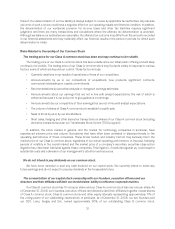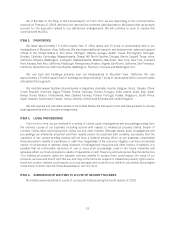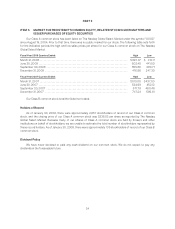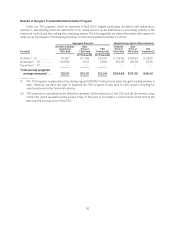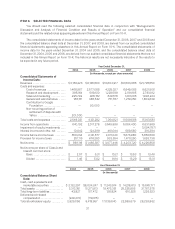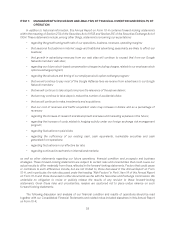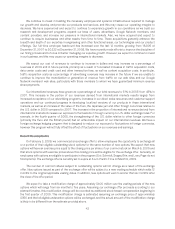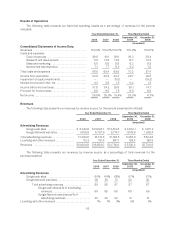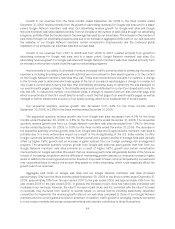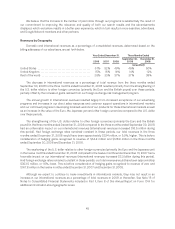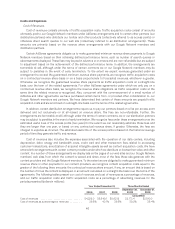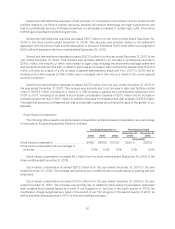Google 2008 Annual Report Download - page 56
Download and view the complete annual report
Please find page 56 of the 2008 Google annual report below. You can navigate through the pages in the report by either clicking on the pages listed below, or by using the keyword search tool below to find specific information within the annual report.AdSense for content is our online service for distributing ads from our advertisers that are relevant to content
on our Google Network members’ web sites. Under this program, we use automated technology to analyze the
meaning of the content on the web page and serve relevant ads based on the meaning of such content. For
example, a web page on an automotive blog that contains an entry about vintage cars might display ads for
vintage car parts or vintage car shows. These ads are displayed in spaces that our AdSense for content partners
have set aside on their web sites. AdSense for content allows a variety of ad types to be shown, including text ads,
image ads, Google Video Ads, link units (which are sets of clickable links to topic pages related to page content),
themed units (which are regular text ads with graphic treatments that change seasonally and by geography) and
gadget ads (which are customized “mini-sites” that run as ads on AdSense publisher web sites).
For our online AdSense program, our advertisers pay us a fee each time a user clicks on one of our
advertisers’ ads displayed on our Google Network members’ web sites or, for those advertisers who choose our
cost-per-impression pricing, as their ads are displayed. To date, we have paid most of these advertiser fees to our
Google Network members, and we expect to continue doing so for the foreseeable future. We recognize these
advertiser fees as revenue and the portion of the advertiser fee we pay to our Google Network members as traffic
acquisition costs under cost of revenues. In some cases, we guarantee our Google Network members minimum
revenue share payments based on their achieving defined performance terms, such as number of search queries
or advertisements displayed. Google Network members do not pay any fees associated with the use of our
AdSense program on their web sites.
Our agreements with Google Network members consist largely of uniform online “click-wrap” agreements
that members enter into by interacting with our registration web sites. The standard agreements have no stated
term and are terminable at will. Agreements with our larger members are individually negotiated. Both the standard
agreements and the negotiated agreements contain provisions requiring us to share with the Google Network
member most of the advertiser fees generated by users clicking on ads on the Google Network member’s web site
or, for advertisers who choose our cost-per-impression pricing, as the ads are displayed on the Google Network
member’s web site.
Google TV Ads enables advertisers, operators and programmers to buy, schedule, deliver and measure ads on
television. We recognize as revenue the fees charged advertisers each time an ad is displayed on television. Google
Audio Ads enables the distribution of our advertisers’ ads for broadcast on radio programs. We recognize as
revenue the fees charged advertisers each time an ad is broadcasted or a listener responds to that ad.
We have entered into arrangements with certain content providers under which we distribute or license their
video and other content. Our agreements with content providers are typically standard agreements with no stated
term and are terminable at will. Agreements with our larger members are individually negotiated. Both the standard
agreements and the negotiated agreements contain provisions requiring us to pay the content providers for the
content we license. In a number of these arrangements, we display ads on the pages of our web sites and our
Google Network members’ web sites from which the content is viewed and share most of the fees these ads
generate with the content providers and Google Network members. We recognize these advertiser fees as revenue.
We recognize the portion of the advertiser fees we pay to our content providers as content acquisition costs under
cost of revenues and the portion we pay to our Google Network members as traffic acquisition costs. In some
cases, we guarantee our content providers minimum revenue share or other payments.
In the first quarter of 2008, we acquired DoubleClick, a company that offers online ad serving and
management services to advertisers, ad agencies and web site publishers. Fees derived from hosted, or web-based
applications, such as the fees we receive for DoubleClick, are recognized as licensing and other revenues in the
period the advertising impressions are delivered.
We believe the factors that influence the success of our advertising programs include the following:
• The relevance, objectivity and quality of our search results and the relevance and quality of ads displayed
with each search results page.
40



